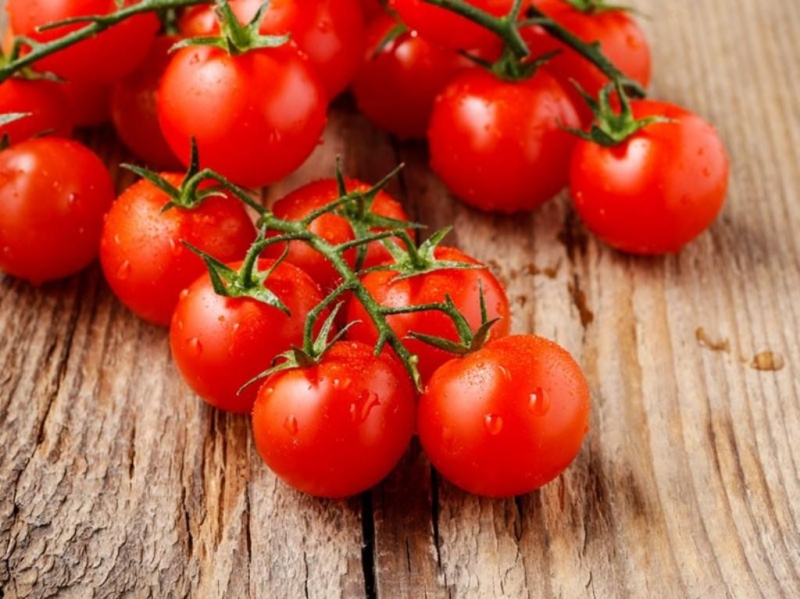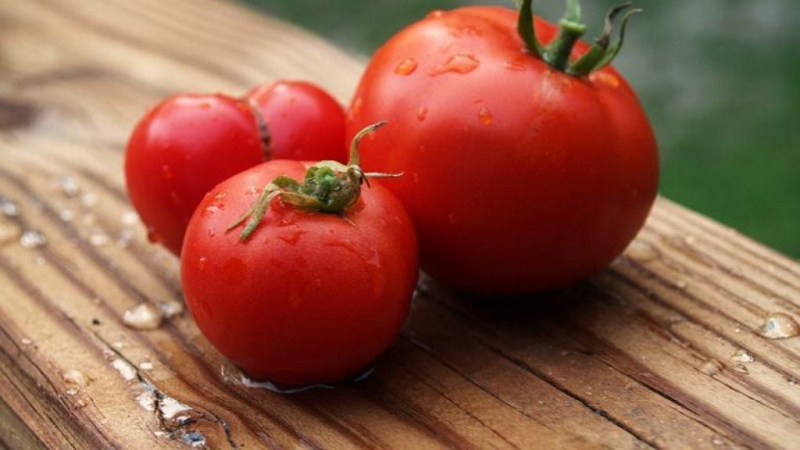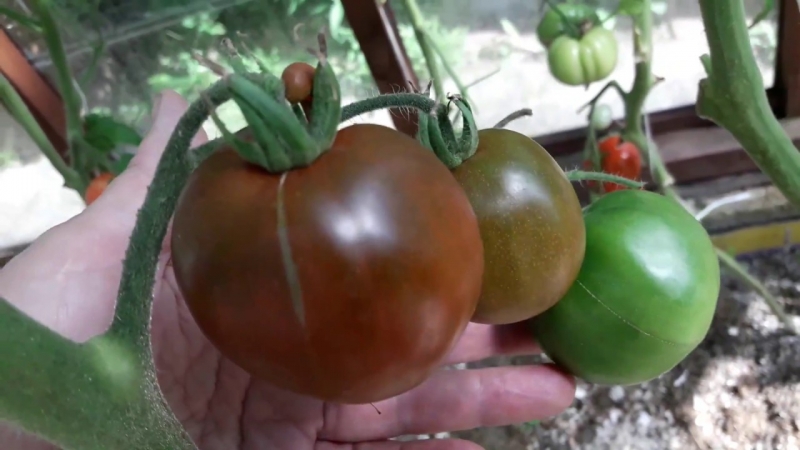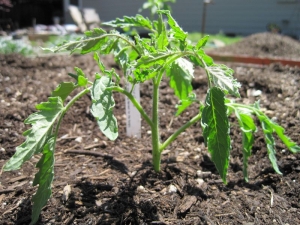Step-by-step instructions on how to grow a tomato "Currency": description and secrets of competent care
Tomato "Valutny" was created by Siberian breeders specifically for the cool Russian climate. The creators of the variety were faced with the task of creating a tomato that can take root and bear fruit in the northern regions of the country. As time has shown, they completely coped with this.
The content of the article
Description, characteristics and photos of tomatoes
Tomato Currency firmly endures night frosts and daytime heat, prolonged rains and droughts, although this affects the volume of the crop. At the same time, the currency tomato is widespread in the central and southern regions.
Currency - a medium-sized determinant variety that does not grow above 60-80 cm, which is quite a lot for tomatoes in his category. The stem of the plant is strong, but without a garter it easily breaks under the weight of ripe fruits. The leaves are densely planted, in summer they protect the stems from the scorching rays of the sun.
Currency tomato boasts excellent immunity to the vast majority of diseases:
- phytophotrose;
- rot;
- septoria and others.
But with mistakes in care, even he is not immune from diseases.



Planting seeds
For cultivation of the variety, soft, humus-rich and loosened soils are preferred.... You can buy a substrate for growing seedlings at a flower shop or make yourself. For this you need:
- mix peat, top sod, regular soil and silt from the river;
- then add phosphorus and potash fertilizers.
Before planting the seeds, such a mixture is calcined over low heat for disinfection. Seedling containers, especially those used for several years, also need to be disinfected with soapy water and fungicides.
After opening the bag with seeds, you need to sort them, sifting out all the spoiled ones.
To do this, they are immersed in a weak salt solution for 5 minutes, in which all light, non-viable seeds will float to the surface, and those ready for germination will settle to the bottom.
Selected seeds are immersed in a solution of fungicides diluted with warm water for at least half an hour and then dried. For details of treatment with each specific fungicide, check the instructions. If desired, you can treat them with growth stimulants (Epin, Radifarm, Kornevin) by wrapping them in gauze and placing them in a solution for 6 hours.
Planting seeds in seedling containers is carried out from late February to early March:
- The containers are filled with purchased soil or prepared mixture.
- Sprinkle with warm water.
- Make indentations in the soil with your finger no more than 1 cm and lower a seed into each of them.
- For high germination of seeds, temperatures in the range of 20-25 ºС are required, therefore, if necessary, they are covered with plastic wrap to create a mini-greenhouse.
After the appearance of green shoots, the film is removed. After the appearance of the first two leaves, the seedlings are picked. Each sprout is planted in a separate pot, being careful not to damage the fragile roots.
During the growth of seedlings, the substrate must remain moist. Make sure that excess moisture does not accumulate in the container, which can cause rotting of the roots.
Growing
 After the final leaving of the night frosts, the sprouts are planted in a greenhouse or in open ground. They do this on pre-weeded and harrowed beds, having previously prepared material for mulching - straw or sawdust. Tomato beds cannot be planned in the place where nightshades (potatoes) were grown last year.
After the final leaving of the night frosts, the sprouts are planted in a greenhouse or in open ground. They do this on pre-weeded and harrowed beds, having previously prepared material for mulching - straw or sawdust. Tomato beds cannot be planned in the place where nightshades (potatoes) were grown last year.
When forming holes, it is recommended to make gaps of 40 cm along one coordinate axis and 60 cm along the other.With this scheme, the four nearest holes look like the corners of a quadrangle with sides of 40 × 60 cm.
It is advisable to add a little pure humus to each hole.... When planting tomatoes, the holes are watered with warm water, dripped and sprinkled with an even layer of mulch.
Tomato Currency is watered at a frequency of at least 4-5 times a month. The frequency of watering depends on the amount of precipitation and air temperature.
When watering, try pour water on the ground, and not on the bushes themselves: the latter is fraught with a deterioration in plant health. At least twice a season, the plant is fertilized with superphosphates and ammonium nitrate, adding their solution (in a ratio of 1:10) directly under the roots. Pay attention to the composition of the additives: no chlorine content is allowed.
Two weeks after planting, the tomatoes are stepchild, breaking off a couple of leaves and lateral shoots from each bush with the exception of the 2-3 most developed ones. This procedure is needed to form large fruits. Do not forget to weed the time about the time and tie up the bushes at the right time.
Common parasites and pests of tomatoes:
- Colorado beetle;
- spider mite;
- whitefly butterflies.
Unfortunately, there is still no tomato variety that would be immune to them. In this regard, the bushes must be treated with insect control preparations.
One of the most common tomato diseases is late blight. Its main reason is excessive watering of the plant. Treatment consists in temporarily reducing the frequency of watering and ensuring the maximum flow of fresh air to the bush.
Harvesting
 Tomato Currency belongs to high-yielding varieties... Fruit ripening begins about four months after germination.
Tomato Currency belongs to high-yielding varieties... Fruit ripening begins about four months after germination.
Tomato fruits have a juicy pulp and a beautiful dense rind, do not crack when ripe.
The mass of a mature fruit ranges from 100 to 200 grams, their number on one hand can reach 6 pieces.
Productivity from 1 sq.m. plantings (that is, from 3-4 bushes) is up to 6 kg.
The fruits are good for:
- canning;
- making delicious freshly squeezed juice and homemade sauces;
- additions to salads and many other dishes.
Advantages and disadvantages of the variety
The main advantage of Currency is its excellent taste and versatility in cooking. Marketable appearance, long term injury and resistance to transportation make Currency one of the most popular tomatoes on store shelves. In addition, the variety is resistant to diseases and unpretentious to weather conditions, and in the cold regions of our homeland it remains one of the few available alternatives.
The variety has no significant shortcomings as such... You can find critical remarks regarding certain features of care and characteristics of the variety. As a rule, they are based on the subjective bias of individual farmers.
Farmers reviews
Owners of beds with Currency often speak well of its high yield and fruit quality, note the relative ease of care.
Mulching the beds makes it difficult for weeds to grow and saves you from having to weed bushes for a long time, which cannot but be appreciated by people with diseases of the spine and knee joints.
Growing Currency saves time and money spent on fighting plant ailments. At the same time, it is noted that greenhouses with tomatoes have to be regularly ventilated for better growth of bushes. Those who grow it for sale praise the beauty of the fruit, as if descended from a picture of a glossy magazine.
Outcome
Tomato Currency can be compared with a Siberian beauty: this variety is endowed with good health, unpretentiousness and charming appearance. He knows how to attract attention to himself and fully justifies the strength and soul invested in him.
We offer you to watch a useful video with an overview of the Curly tomato variety and about its sowing: